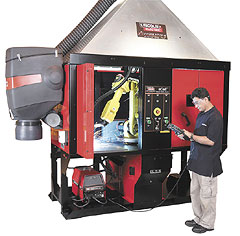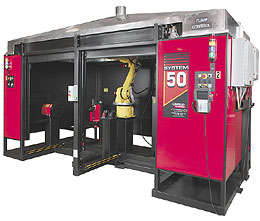Robotics and Automation
Robotics and Automation Can Save Your Factory
by Rick Schneider
President & CEO FANUC Robotics Americas, Inc. Rochester Hills, Michigan
Moving manufacturing operations overseas is not the only route to remaining competitive. By focusing on innovation and recognizing that automation and robotics are often more cost-effective and profitable alternatives, North American manufacturing companies can achieve cost-savings while improving quality and control.
As North American manufacturers face ever-growing challenges to remain competitive in the global marketplace, they frequently look to overseas sources as a way to cut costs. Although the appeal of low-cost labor may lead a company to implement this course, and it sometimes makes sense, there are numerous other factors to consider. Among them are factory efficiency, inventory requirements, the strength of the U.S. labor force, government support and stability, supply chain strength, and intellectual property protection.
China has become one of the strongest outsourcing locations, but maintaining high product quality can be more difficult when manufacturing there or in other low-wage countries. Moving production offshore adds the risk of currency fluctuations, longer lead times, shipping delays, and loss of control of both the manufacturing process and intellectual property. Counterfeiting is another serious problem, with a $3 billion annual cost to the U.S. automotive parts industry alone. A report by The Boston Consulting Group further points out that lead time, delivery performance and product quality varies widely. According to the report, one U.S. company outsourcing in China received quotes for some parts that varied by as much as 80 percent, compared with variations of two to five percent from United States sources. The U.S. Embassy in Beijing also says that companies investing in the Chinese market underestimate the market situation and fail to perform risk assessment or seek council, as doing business in China may often pose a greater risk. In fact, some investors have fallen into bad business deals, resulting in lost investments.
Automate and Save Your Factory
Outsourcing is seldom an all-or-nothing proposition. According to The Boston Consulting Group, it makes sense to outsource some products or manufacturing processes, including those that require extensive hand labor. However, highly automated manufacturing processes, products that need a final finishing step and heavy products in which labor savings cannot compete for the freight penalty are better located in the home country.
Before abandoning existing plants and shipping manufacturing overseas, a company should consider applying innovation and product enhancing technologies such as automation. This can negate the advantages of low-wage countries. Some manufacturers, in attempting to keep their factories open, express concern that investing in automation could displace workers. However, manufacturers that do not innovate and embrace automation leave themselves open to losing their entire manufacturing site, or even their company, to outsourcing.
The same kind of dilemma played out successfully in the agricultural economy of the last century and in the U.S. steel industry. In 1900, agricultural workers constituted more than 38 percent of employment, compared with about two percent today. Yet, we produce more of the world's food. Likewise, the number of workers employed by the U.S. steel industry dropped by 74 percent, from 289,000 to 74,000, while output increased by 36 percent, from 75 million tons to 102 million tons.
Automation can directly impact quality and efficiency, increase control and improve viability. Because one robot can perform the work of three to five people, direct labor costs are reduced. This is doubly important because, over the next three decades, 76 million baby boomers will retire, and only 46 million new workers will be available to replace them. Despite this shortage, the demand for labor will continue, and automation provides a solution. An automated facility is designed to manufacture the highest quality products and allow manufacturers to optimize current capital and labor resources. With automation, manufacturers can maintain control of their operations, strengthen North American manufacturing leadership and retain jobs, with significant cost improvements. Of all forms of automation, robotic automation proves to be the most flexible and offers more opportunities for companies to maintain profitability in operations of all sizes.
To support the case for manufacturing in North America and challenge corporations to look at the entire picture when deciding whether to move overseas, FANUC Robotics America and The Lincoln Electric Company are leading an initiative named "Save Your Factory." It is designed to give manufacturers an objective comparison of the benefits, real costs and impact of automating operations versus moving them offshore. "Save Your Factory" encourages companies to weigh the unknowns and investigate opportunities within their current facility that will help it remain competitive. Efficiency data indicates that automation, robotics and other lean manufacturing operations can enable North American operations to be cost-competitive with countries like China.
As quality and efficiency in production are essential to survival, the focus has already shifted to lean manufacturing and the Six Sigma process. Although many of the other initiatives proposed to improve this country's manufacturing competitiveness will take years to accomplish, companies can maintain or improve their competitive position by moving ahead now with automation and other lean manufacturing operations.
Case Studies: Lower Costs, Higher Productivity
One of the most important factors in choosing to move a factory overseas is cost. Real-life examples demonstrate that automation and robotics can provide the cost-savings companies are looking for without outsourcing.
The Lincoln Electric Company, the world's leading designer and manufacturer of arc welding products, robotic welding systems and plasma and oxyfuel cutting systems, recently worked with a customer who was considering such a move. By analyzing the cost of part production in China versus the cost of automation at the company's US location, Lincoln Electric determined that costs of both options were equal at 30 cents per part, compared to 84 cents per part for the customer's existing manual process. However, applying robotics to keep the process in-plant enhanced quality, improved process control and significantly reduced lead times compared to China. In addition, robots help manufacturers to optimize equipment cell layout, floor space usage, work piece flow and flexibility. They also eliminate human error, reduce handling accidents and can be implemented in a variety of applications and locations.
In another case, Mennie's Machine Company met production goals with a fully automated system consisting of ten consecutive work cells linked by a conveyor. Mennie's Machine Company manufactures drive shaft components for sport utility vehicles and full-size trucks. Bottlenecks in their manual system, which yielded 80 pieces per hour, prevented them from achieving their production goal of 118 pieces per hour. FANUC Robotics developed a "factory within a factory," incorporating material handling robot models equipped with HandlingTool™ and Collision Guard™ software, customer grippers and a control interface.
At the same time, Mennie's addressed production quality by tracking scrap dollars. During final inspection, each part is examined for dimensional tolerance and cosmetic appearance. Rejects are tagged and evaluated further to determine how to eliminate inaccuracy. Since the automated system was installed, scrap rates have declined, and the three-shift operation is running at 95 percent uptime, a 15 percent increase over the previous manual operation. The robotic system has helped reduce total production costs by approximately 25 percent and is expandable to accommodate additional machines or new part designs. Among the competitive advantages the company gained are accurate and consistent part loading, a reduction in part defects, increased productivity (typically 120 pieces per hour), improved control of the entire manufacturing system, lower cost per piece, and flexibility to meet future production demands.
At Lamson & Sessions, a leading producer of thermoplastic enclosures, fittings, conduit and pipe, and wiring devices for the electrical, telecommunications, consumer, power and waste water markets, a FANUC tabletop robot system that dispenses a FIP (formed in place) gasket replaced a manual operation. It netted a sizeable cost savings by eliminating the previous cut-foam gaskets, and the more consistent performance of the automated process significantly increased product quality. The robot offers floor, invert, wall, shelf and angle mounting, which allows better access to unusual work places. For Lamson & Sessions, it is flexible enough to handle 13 different configurations, as well as additional parts in the future.
Saving Your Factory
Although many people believe that manufacturing is destined to move to the countries with the lowest labor rates, the facts show that it will move to the countries whose companies reduce production costs and improve quality through automation. Considering all the potential problems connected with overseas outsourcing, it's worth the time to investigate and evaluate the options for remaining competitive with existing facilities. The site www.saveyourfactory.com is a good place to start. It includes more information and a set of resources that includes access to a variety of system integrators, as well as audit and analysis tools to examine automation options to help companies maintain competitive manufacturing operations in North America.


